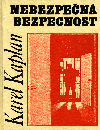 |
Vol 2, No 1
10 January 2000 |
|
|
 B O O K R E V I E W:
B O O K R E V I E W:
Nebezpečná bezpečnost: Státní bezpečnost 1948-1956 [Dangerous Security: The State Security Service 1948-1956] Karel Kaplan Doplněk, Brno, 1999. 277 pp. [Czech only] ISBN 80-7239-024-4. David Lightfoot Ten years after the Czechoslovak government declared that it would not prosecute citizens for their political crimes as its Communist predecessors had done, Czech interest in the history of the State Security agency (the StB) is on the increase. Popular media promotes an image of the State Security agents as part of a great absurdity visited upon Czechs: agents in films such as Kolja and Báječná léta pod psa (The Blissful Years of Lousy Living, based on the novel of the same name by Michal Viewegh) are damned as much for their dearth of humor as for their political activities. Curious minds can look up their former (and perhaps current) adversaries, friends and ex-spouses in the Onion pages, a published list of StB agents, operatives and collaborators. It seems possible that memories of the StB will be trivialized and obscured to all but those who suffered directly. Karel Kaplan's new history Nebezpečná bezpečnost: Státní bezpečnost 1948-1956 [Dangerous Security: The State Security Service 1948-1956], however, eschews both the nostalgic and vengeful tones of more popular portrayals of the Czech secret police in favor of a detailed history of the infamous, but elusive security agency and its role in the hysteria of the Stalinist Czechoslovak Socialist Republic. Kaplan is the author of many studies of this period; perhaps his best known work is Zpráva o zavraždění generálního tajemníka [The Murder of the General Secretary], first published in Prague in 1992), about the infamous Slánský trial of 1952. He has also written two other histories of Stalinist Czechoslovakia published in this same series (Edice Knihy Dokumentů): Pět Kapitol o únoru [Five Chapters on February] and Největší politický proces: Milada Horáková a spol [The Biggest Political Trial: Milada Horáková and Co.]. In his latest work, he argues that an understanding of how the State Security Service was formed and operated is key to an understanding of the dynamics of the era. Where many less scholarly histories merely blame the StB for crimes and political repression, Nebezpečná bezpečnost examines how the security agency, a tool of the Party, fell victim to the very hysteria that it had helped to create. In his study Kaplan does not simplify the structure and number of competing organizations and departments, nor does he speculate as to their motives. The first chapter traces the development of State Security in postwar Czechoslovakia, from the hiring of 2000 young Communists in 1948 and the invitation of Soviet advisors, to the organization's development into a viable political tool, which the author describes as the government's most stalwart means of protection of its monopoly of power. Kaplan lists the organizations and departments of State Security and analyzes the various ranks within the State Security from officers to rank-and-file employees. The last section of this chapter constitutes a genealogy of the major actors in the StB from the Communist coup in 1948 through to 1956. Of most interest to readers is Kaplan's analysis of the who, what, where and when of the StB provided in the second chapter. Here he lists specific activities of the Security Services and their subtly evolving mission. This is perhaps the most fact-packed section of the study. There is an extensive list of political assassinations, intrigue and manipulations, from the famous (the murder of Šrám), to the obscure. There is even a specific count of agents who remained loyal to the StB as emigres, although their significance is unfortunately not discussed. One is sometimes left bewildered by the lists of names and numbers, and hungry for narratives and analysis. Moreover, relatively famous historical figures such as Peroutka are presented without any introduction, and thus the uninformed reader may become disoriented. The final selection, "Justice, the Communist Party and State Security", is the most ambitious, although the title is a bit of a misnomer. Developing themes from the first chapters, it shows how the Party and the State Security acted together to persecute and in some cases eliminate individuals. It covers specific trials as well as protocol as to how people were arrested, tried and executed both publicly and secretly. It is top heavy. The final chapter and the conclusion make the most persuasive arguments for the book, and explore material that might well have been more useful in the introduction. Kaplan's study presents a staggering amount of research that will be of great use to historians. There is likewise a large selection of supplementary materials, but Nebezpečná bezpečnost remains short of bibliographical references, methodological discussion and background information for the non-specialist. Nonetheless this history sheds light on the impact and significance of the State Security in the ČSSR, a topic worth returning to after ten years of forgetting.
David Lightfoot, 8 January 2000 Nebezpečná bezpečnost is available from from the Czech on-line bookshop Vltava |
|
![]()
Copyright (c)
2000 - Central Europe Review and Internet
servis, a.s.
All Rights Reserved
